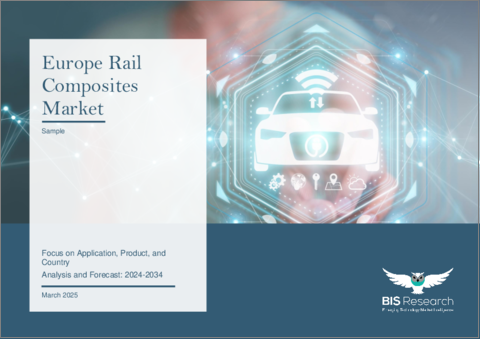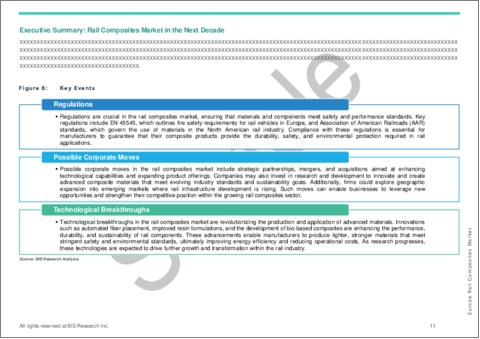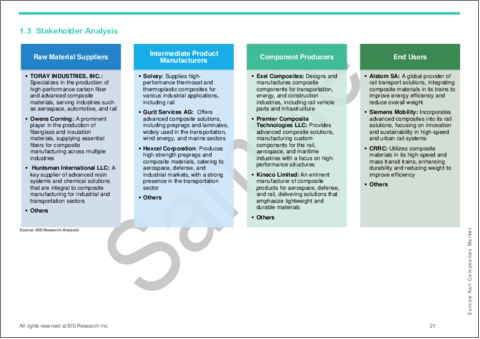|
|
市場調査レポート
商品コード
1689630
欧州の鉄道用複合材料市場:用途別、製品別、国別 - 分析と予測(2024年~2034年)Europe Rail Composites Market: Focus on Application, Product, and Country - Analysis and Forecast, 2024-2034 |
||||||
カスタマイズ可能
|
|||||||
| 欧州の鉄道用複合材料市場:用途別、製品別、国別 - 分析と予測(2024年~2034年) |
|
出版日: 2025年03月28日
発行: BIS Research
ページ情報: 英文 75 Pages
納期: 1~5営業日
|
全表示
- 概要
- 図表
- 目次
欧州の鉄道用複合材料の市場規模は、2024年の3億500万米ドルから2034年には6億3,190万米ドルに達し、予測期間の2024年~2034年のCAGRは7.55%になると予測されています。
欧州の鉄道用複合材料市場は、鉄道輸送に必要な高強度、軽量、エネルギー効率に優れた材料へのニーズの高まりにより拡大しています。複合材料は強度対重量比に優れ、腐食に強く、メンテナンスコストを削減できるため、車両、構造要素、内装に頻繁に使用されています。二酸化炭素排出量の削減と燃料効率の改善への取り組みは、持続可能なモビリティに対する欧州の強いコミットメントと複合材技術の進歩によって支えられています。市場の拡大をさらに後押ししているのは、鉄道インフラ、特にドイツ、フランス、英国の高速鉄道や地下鉄プロジェクトへの大規模投資です。これらの要素により、欧州の鉄道用複合材料市場は安定的かつ持続的に成長する立場にあります。
| 主要市場統計 | |
|---|---|
| 予測期間 | 2024年~2034年 |
| 2024年の評価 | 3億500万米ドル |
| 2034年の予測 | 6億3,190万米ドル |
| CAGR | 7.55% |
欧州の鉄道用複合材料市場は、鉄道輸送における高強度、軽量、エネルギー効率に優れた材料へのニーズの高まりにより、着実に拡大しています。炭素繊維複合材料やガラス繊維強化プラスチック(FRP)のような複合材料は、強度重量比に優れ、腐食に強く、メンテナンスが少なくて済むため、鉄道車両、構造要素、内装に最適です。鉄道産業における先端複合材料の使用は、持続可能なモビリティに対する欧州連合の強いコミットメントと厳しい環境規制によってさらに加速しています。
鉄道インフラの近代化、特にドイツ、フランス、英国、その他の欧州諸国における高速鉄道や地下鉄プロジェクトへの継続的な投資により、市場は急速に拡大しています。また、リサイクル可能で耐火性のある複合材料の新規開発も、持続可能性の目標と安全規制を満たすため、人気が高まっています。さらに、二酸化炭素排出量の削減と燃費の向上を推進する結果、エネルギー効率を向上させる軽量複合材料の使用が増加しています。
欧州の鉄道用複合材市場は、複合材技術の開発が進み、官民からの投資が増加していることから、長期的な成長が見込まれています。欧州における持続可能な鉄道輸送の将来は、鉄道事業者が高性能でリーズナブルな価格の材料を求めていることから、複合材料によって大きく形作られると予測されています。
当レポートでは、欧州の鉄道用複合材料市場について調査し、市場の概要とともに、用途別、製品別、国別の動向、および市場に参入する企業のプロファイルなどを提供しています。
目次
エグゼクティブサマリー
第1章 市場:業界の展望
- 動向:現在および将来の影響評価
- サプライチェーンの概要
- 研究開発レビュー
- 規制状況
- ステークホルダー分析
- 主要な世界的イベントの影響分析
- 市場力学の概要
第2章 地域
- 地域サマリー
- 欧州
- 地域概要
- 市場成長促進要因
- 市場成長抑制要因
- ドイツ
- フランス
- 英国
- イタリア
- その他
第3章 市場-競合ベンチマーキングと企業プロファイル
- 今後の見通し
- 地理的評価
- 3A Composites
- BASF
- Dartford Composites Ltd
- Exel Composites
- Gurit Services AG
- LANXESS
- Solvay
第4章 調査手法
List of Figures
- Figure 1: Europe Rail Composites Market (by Scenario), $Million, 2023, 2027, and 2034
- Figure 2: Rail Composites Market (by Region), $Million, 2023, 2027, and 2034
- Figure 3: Europe Rail Composites Market (by Application), $Million, 2023, 2027, and 2034
- Figure 4: Europe Rail Composites Market (by Fiber Type), $Million, 2023, 2027, and 2034
- Figure 5: Europe Rail Composites Market (by Resin Type), $Million, 2023, 2027, and 2034
- Figure 6: Key Events
- Figure 7: Key Benefits and Characteristics of High-Performance Composites
- Figure 8: Major Advancements in Rail Composite Manufacturing
- Figure 9: Patent Filed (by Country), January 2021-September 2024
- Figure 10: Patent Filed (by Company), January 2021-September 2024
- Figure 11: Five Major Use Cases of Composites in the Rail Industry
- Figure 12: Impact Analysis of Europe Rail Composites Market Navigating Factors, 2024-2034
- Figure 13: Global Share of Passenger Kilometres (by Region), 2024
- Figure 14: Germany Rail Composites Market, $Million, 2023-2034
- Figure 15: France Rail Composites Market, $Million, 2023-2034
- Figure 16: U.K. Rail Composites Market, $Million, 2023-2034
- Figure 17: Italy Rail Composites Market, $Million, 2023-2034
- Figure 18: Rest-of-Europe Rail Composites Market, $Million, 2023-2034
- Figure 19: Strategic Initiatives, January 2021-September 2024
- Figure 21: Data Triangulation
- Figure 22: Top-Down and Bottom-Up Approach
- Figure 23: Assumptions and Limitations
List of Tables
- Table 1: Market Snapshot
- Table 2: Opportunities across Region
- Table 3: Competitive Landscape Snapshot
- Table 4: Global Average Pricing Analysis ($/Ton)
- Table 5: Rail Composites Market (by Region), $Million, 2023-2034
- Table 6: Europe Rail Composites Market (by Application), $Million, 2023-2034
- Table 7: Europe Rail Composites Market (by Fiber Type), $Million, 2023-2034
- Table 8: Europe Rail Composites Market (by Resin Type), $Million, 2023-2034
- Table 9: Germany Rail Composites Market (by Application), $Million, 2023-2034
- Table 10: Germany Rail Composites Market (by Fiber Type), $Million, 2023-2034
- Table 11: Germany Rail Composites Market (by Resin Type), $Million, 2023-2034
- Table 12: France Rail Composites Market (by Application), $Million, 2023-2034
- Table 13: France Rail Composites Market (by Fiber Type), $Million, 2023-2034
- Table 14: France Rail Composites Market (by Resin Type), $Million, 2023-2034
- Table 15: U.K. Rail Composites Market (by Application), $Million, 2023-2034
- Table 16: U.K. Rail Composites Market (by Fiber Type), $Million, 2023-2034
- Table 17: U.K. Rail Composites Market (by Resin Type), $Million, 2023-2034
- Table 18: Italy Rail Composites Market (by Application), $Million, 2023-2034
- Table 19: Italy Rail Composites Market (by Fiber Type), $Million, 2023-2034
- Table 20: Italy Rail Composites Market (by Resin Type), $Million, 2023-2034
- Table 21: Rest-of-Europe Rail Composites Market (by Application), $Million, 2023-2034
- Table 22: Rest-of-Europe Rail Composites Market (by Fiber Type), $Million, 2023-2034
- Table 23: Rest-of-Europe Rail Composites Market (by Resin Type), $Million, 2023-2034
- Table 24: Global Market Share, 2023
Introduction to Europe Rail Composites Market
The Europe rail composites market is projected to reach $631.9 million by 2034 from $305.0 million in 2024, growing at a CAGR of 7.55% during the forecast period 2024-2034. The European rail composites market is expanding due to the growing need for materials that are strong, lightweight, and energy-efficient for rail transportation. Because of their superior strength-to-weight ratios, resistance to corrosion, and reduced maintenance costs, composites are frequently used in carriages, structural elements, and interiors. Efforts to lower carbon emissions and improve fuel efficiency are supported by Europe's strong commitment to sustainable mobility and advances in composite technology. Further propelling market expansion are large investments in rail infrastructure, especially in high-speed and metro rail projects throughout Germany, France, and the UK. These elements put the European rail composites market in a position to grow steadily and sustainably.
Market Introduction
| KEY MARKET STATISTICS | |
|---|---|
| Forecast Period | 2024 - 2034 |
| 2024 Evaluation | $305.0 Million |
| 2034 Forecast | $631.9 Million |
| CAGR | 7.55% |
The market for rail composites in Europe is expanding steadily due to the growing need for materials that are strong, lightweight, and energy-efficient for rail transportation. Composites, like carbon fibre composites and fiberglass-reinforced plastic (FRP), are perfect for rail carriages, structural elements, and interiors because they have better strength-to-weight ratios, resist corrosion, and require less maintenance. The use of advanced composite materials in the rail industry is being further accelerated by the European Union's strong commitment to sustainable mobility and strict environmental regulations.
The market is expanding faster due to ongoing investments in modernising rail infrastructure, especially in high-speed and metro rail projects throughout Germany, France, the UK, and other European countries. New developments in recyclable and fire-resistant composites are also becoming more popular since they meet sustainability objectives and safety regulations. Additionally, the use of lightweight composite materials, which improve energy efficiency, is growing as a result of the push to lower carbon emissions and improve fuel efficiency.
The market for rail composites in Europe is expected to grow over the long run due to ongoing developments in composite technology and rising investments from the public and private sectors. The future of sustainable rail transport in Europe will be significantly shaped by composites as railway operators look for high-performance, reasonably priced materials.
Market Segmentation
Segmentation 1: by Application
- Interior Components
- Exterior Panels
- Structural Components
- Others
Segmentation 2: by Fiber Type
- Glass Fiber Composites
- Carbon Fiber Composites
- Aramid Fiber Composites
- Others
Segmentation 3: by Resin Type
- Polyester
- Phenolic
- Epoxy
- Vinyl Ester
- Others
Segmentation 4: by Country
- Germany
- U.K.
- France
- Italy
- Rest-of-Europe
How can this report add value to an organization?
Product/Innovation Strategy: This report provides a comprehensive product/innovation strategy for the Europe rail composites market, identifying opportunities for market entry, technology adoption, and sustainable growth. It offers actionable insights, helping organizations to meet environmental standards, gain a competitive edge, and capitalize on the increasing demand for eco-friendly solutions in various industries.
Growth/Marketing Strategy: This report offers a comprehensive growth and marketing strategy designed specifically for the rail composites. It presents a targeted approach to identifying specialized market segments, establishing a competitive advantage, and implementing creative marketing initiatives to optimize market share and financial performance. By harnessing these strategic recommendations, organizations can elevate their market presence, seize emerging prospects, and efficiently propel revenue expansion.
Competitive Strategy: This report crafts a strong competitive strategy tailored to the Europe rail composites market. It evaluates market rivals, suggests stand-out methods, and offers guidance for maintaining a competitive edge. By adhering to these strategic directives, companies can position themselves effectively in the face of market competition, ensuring sustained prosperity and profitability.
Key Market Players and Competition Synopsis
The companies profiled in the report have been selected based on input gathered from primary experts and analyzing company coverage, product portfolio, and market penetration.
Some of the prominent names in the rail composites market are:
- 3A Composites
- BASF
- Dartford Composites Ltd
- Exel Composites
- Gurit Services AG
- LANXESS
- Solvay
Table of Contents
Executive Summary
Scope and Definition
1 Market: Industry Outlook
- 1.1 Trends: Current and Future Impact Assessment
- 1.1.1 Demand for High-Performance Composites
- 1.1.2 Rapid Advancements in Manufacturing Processes
- 1.2 Supply Chain Overview
- 1.2.1 Value Chain Analysis
- 1.2.2 Pricing Forecast
- 1.3 Research and Development Review
- 1.3.1 Patent Filing Trend (by Country and Company)
- 1.4 Regulatory Landscape
- 1.5 Stakeholder Analysis
- 1.5.1 Use Case
- 1.5.1.1 Case Study 1: Composite Profiles for Siemens Desiro ML Concept
- 1.5.1.2 Case Study 2: Composite Cab Fronts and Interiors for Transperth B-series
- 1.5.2 End User and Buying Criteria
- 1.5.1 Use Case
- 1.6 Impact Analysis for Key Global Events
- 1.7 Market Dynamics Overview
- 1.7.1 Market Drivers
- 1.7.1.1 Expanding Public Rail Transit Infrastructure
- 1.7.1.2 Growing Emphasis on Material Efficiency in the Rail Industry
- 1.7.2 Market Challenges
- 1.7.2.1 High Initial Costs
- 1.7.2.2 Regulatory Compliance and Certification
- 1.7.3 Market Opportunities
- 1.7.3.1 Advancements in Lightweight Train Designs
- 1.7.3.2 Demand for Sustainable and Low-Maintenance Materials
- 1.7.1 Market Drivers
2 Region
- 2.1 Regional Summary
- 2.2 Europe
- 2.2.1 Regional Overview
- 2.2.2 Driving Factors for Market Growth
- 2.2.3 Factors Challenging the Market
- 2.2.3.1 Application
- 2.2.3.2 Product
- 2.2.4 Germany
- 2.2.4.1 Application
- 2.2.4.2 Product
- 2.2.5 France
- 2.2.5.1 Application
- 2.2.5.2 Product
- 2.2.6 U.K.
- 2.2.6.1 Application
- 2.2.6.2 Product
- 2.2.7 Italy
- 2.2.7.1 Application
- 2.2.7.2 Product
- 2.2.8 Rest-of-Europe
- 2.2.8.1 Application
- 2.2.8.2 Product
3 Markets - Competitive Benchmarking & Company Profiles
- 3.1 Next Frontiers
- 3.2 Geographic Assessment
- 3.2.1 3A Composites
- 3.2.1.1 Overview
- 3.2.1.2 Top Products/Product Portfolio
- 3.2.1.3 Target Customers
- 3.2.1.4 Key Personnel
- 3.2.1.5 Analyst View
- 3.2.1.6 Market Share, 2023
- 3.2.2 BASF
- 3.2.2.1 Overview
- 3.2.2.2 Top Products/Product Portfolio
- 3.2.2.3 Target Customers
- 3.2.2.4 Key Personnel
- 3.2.2.5 Analyst View
- 3.2.2.6 Market Share, 2023
- 3.2.3 Dartford Composites Ltd
- 3.2.3.1 Overview
- 3.2.3.2 Top Products/Product Portfolio
- 3.2.3.3 Target Customers
- 3.2.3.4 Key Personnel
- 3.2.3.5 Analyst View
- 3.2.3.6 Market Share, 2023
- 3.2.4 Exel Composites
- 3.2.4.1 Overview
- 3.2.4.2 Top Products/Product Portfolio
- 3.2.4.3 Target Customers
- 3.2.4.4 Key Personnel
- 3.2.4.5 Analyst View
- 3.2.4.6 Market Share, 2023
- 3.2.5 Gurit Services AG
- 3.2.5.1 Overview
- 3.2.5.2 Top Products/Product Portfolio
- 3.2.5.3 Target Customers
- 3.2.5.4 Key Personnel
- 3.2.5.5 Analyst View
- 3.2.5.6 Market Share, 2023
- 3.2.6 LANXESS
- 3.2.6.1 Overview
- 3.2.6.2 Top Products/Product Portfolio
- 3.2.6.3 Target Customers
- 3.2.6.4 Key Personnel
- 3.2.6.5 Analyst View
- 3.2.6.6 Market Share, 2023
- 3.2.7 Solvay
- 3.2.7.1 Overview
- 3.2.7.2 Top Products/Product Portfolio
- 3.2.7.3 Target Customers
- 3.2.7.4 Key Personnel
- 3.2.7.5 Analyst View
- 3.2.7.6 Market Share, 2023
- 3.2.1 3A Composites
4 Research Methodology
- 4.1 Data Sources
- 4.1.1 Primary Data Sources
- 4.1.2 Secondary Data Sources
- 4.1.3 Data Triangulation
- 4.2 Market Estimation and Forecast





